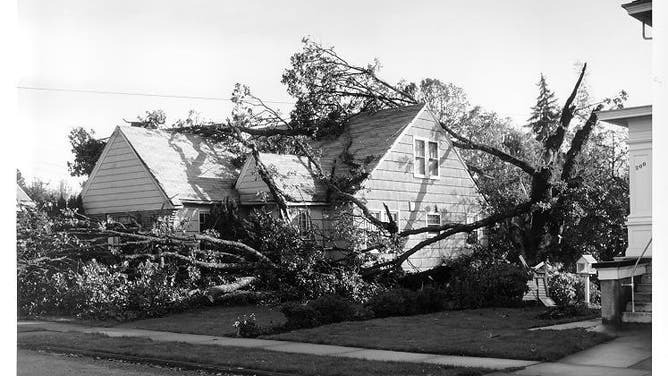It was 62 years ago when one of the most powerful storms in the history of the Pacific Northwest wreaked havoc on the region. Known as the Columbus Day Storm of 1962, this catastrophic event struck with winds comparable to a Category 3 hurricane, leaving a trail of destruction across Oregon, Washington, Northern California, and British Columbia. Dozens lost their lives, and the storm caused widespread damage, forever marking October 12, 1962, in the weather annals of the Pacific Northwest. As we approach October 14 this year, which is now widely recognized as Indigenous Peoples Day, it is a time to reflect not only on the past but also on the growing intensity of storms we witness today, such as Hurricane Helene.
While the Columbus Day Storm was devastating, the extreme weather patterns we are experiencing in modern times bring an even greater sense of urgency to conversations about climate change. Hurricane Helene, currently threatening coastal areas with unprecedented fury, serves as a stark reminder that while history can be catastrophic, the future may hold even more dangerous storms. The winds of Hurricane Helene have already surpassed what was seen in 1962, and the damage it's predicted to cause has drawn comparisons to past disasters, though experts warn it could exceed those expectations.

The Columbus Day Storm, often called the "Big Blow," is still considered the most intense windstorm ever to hit the Pacific Northwest in the 20th century. The storm had its origins in the Western Pacific as Typhoon Freda, which dissipated before crossing the ocean. But as its remnants reached the coast of Northern California, they merged with a new system, rapidly intensifying. When it slammed into Oregon on October 12, it brought extraordinary wind speeds, with gusts recorded at 138 mph in Newport, 127 mph in Corvallis, and 116 mph on the Morrison Bridge in Portland.
The devastation in Oregon was especially severe. As the storm roared through the state, it left a path of destruction that took years to recover from. The Willamette Valley, a region that rarely experiences such extreme weather, was hit hardest. Entire communities were paralyzed by the storm’s fury. In Lake Oswego, 70% of homes suffered significant wind damage, and across the state, power outages stretched for weeks in some areas. Thousands of Oregonians were left in the dark as the storm knocked out power lines, toppled trees, and demolished infrastructure.

The state's timber industry was one of the hardest-hit sectors, with the storm felling approximately 11.2 billion board feet of timber. This loss was catastrophic for Oregon’s economy, as the fallen trees included countless old-growth specimens, some of which had stood for over a thousand years. The forests, which define much of Oregon’s natural beauty, were forever altered. The timber loss was so vast that it took months to clear the debris, and even today, remnants of the storm’s destruction can be found in some of Oregon's forested areas.
Do you love Oregon?
Sign up for monthly emails full of local travel inspiration and fun trip ideas. In each newsletter we'll share upcoming events, new things to do, hot dining spots and great travel ideas.
The storm’s sudden intensity caught many by surprise. Portland’s normally bustling streets were quickly turned into a landscape of wreckage as gusts over 100 mph tore through the city. The Morrison Bridge, one of the key bridges connecting the east and west sides of the city, reported wind gusts of 116 mph, making it one of the strongest wind events ever recorded in Portland’s history. Power lines snapped like twigs, and windows shattered as the storm pummeled the city. In Portland and surrounding areas, the clean-up took months, and the storm left a lasting scar on the city’s infrastructure.
Smaller towns, too, faced the brunt of the storm. Coastal communities like Newport, which recorded some of the highest wind speeds at 138 mph, were left battered. Fishing boats were thrown onto land, docks were destroyed, and many homes were leveled by the gale-force winds. In rural areas of the state, barns and farmhouses were torn apart, leaving agricultural communities struggling to recover in the aftermath.

Though winds this strong are often associated with hurricanes, the Columbus Day Storm was an extratropical cyclone, meaning it developed outside of the tropics. However, its ferocity rivaled that of major hurricanes. With a central pressure of 960 millibars, it had the strength of a Category 3 hurricane—an impressive feat for a storm in the Pacific Northwest, a region not typically subjected to such severe weather.
Looking back on the storm, it’s hard to fathom the sudden and sheer devastation it caused. Weather historian Dr. Wolf Read noted that the winds struck so quickly and violently that many people didn’t have time to prepare, leaving them scrambling for shelter as the winds howled around them. In just a few hours, lives were lost, homes destroyed, and the region’s economy significantly impacted. The cost of damage in 1962 dollars was around $230 to $280 million, equivalent to approximately $2.4 billion today. The destruction spanned across three states and even reached parts of British Columbia.
Now, as we approach another Columbus Day, the conversation has shifted, with many recognizing it as Indigenous Peoples Day—a time to reflect on the resilience and history of Native American cultures. As we commemorate this day, it’s important to also consider the changing landscape of our planet. Climate change is making storms like Hurricane Helene more frequent and intense, with higher wind speeds, greater rainfall, and more devastating impacts than what was experienced in 1962.
Though the Big Blow was the storm of the century for the Pacific Northwest, today’s hurricanes are creating new benchmarks for devastation. In 1962, storms like this were rare. Today, the increasing number of powerful hurricanes, typhoons, and windstorms raises concerns about how prepared we are for the future. The Columbus Day Storm was a wake-up call for the Pacific Northwest. But with the advent of Hurricane Helene and others like it, the world may soon face even more catastrophic weather events as we grapple with the realities of a changing climate.
As Indigenous Peoples Day approaches, we honor the traditions, strength, and history of Native communities while also acknowledging the pressing challenges of today, including the protection of the environment and the preparedness for the storms yet to come. The Columbus Day Storm serves as a reminder of nature’s power, but it is our responsibility to face the increasing dangers head-on.













